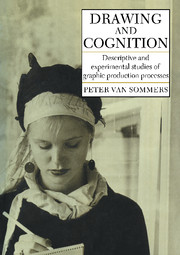Book contents
- Frontmatter
- Contents
- Preface
- 1 Basic executive constraints in drawing
- 2 Maintaining paper contact, anchoring, and planning
- 3 The reproduction of rectilinear figures
- 4 The production of curvilinear forms
- 5 The impact of meaning on executive strategies
- 6 Simple representational drawing
- 7 Difficult graphic tasks: A failure in perceptual analysis?
- 8 Stability and evolution in children's drawings
- 9 Innovations, primitives, contour, and space in children's drawings
- 10 Children's repeated drawings: How are innovations coded?
- 11 The pragmatics of everyday graphic production
- References
- Index
2 - Maintaining paper contact, anchoring, and planning
Published online by Cambridge University Press: 07 October 2011
- Frontmatter
- Contents
- Preface
- 1 Basic executive constraints in drawing
- 2 Maintaining paper contact, anchoring, and planning
- 3 The reproduction of rectilinear figures
- 4 The production of curvilinear forms
- 5 The impact of meaning on executive strategies
- 6 Simple representational drawing
- 7 Difficult graphic tasks: A failure in perceptual analysis?
- 8 Stability and evolution in children's drawings
- 9 Innovations, primitives, contour, and space in children's drawings
- 10 Children's repeated drawings: How are innovations coded?
- 11 The pragmatics of everyday graphic production
- References
- Index
Summary
Paper contact
When subjects reproduce simple geometric forms, the majority of strokes conform to the preferred stroke direction. One important source of exceptions arises from a tendency to keep contact with the paper as the pencil moves from one linear element to another. Subjects not uncommonly turn a corner without lifting off and may then be compelled to proceed in a normally nonpreferred direction. This practice is sometimes called threading, and is of course the factor that in writing distinguishes cursive script from lettering. We have seen that such stroke continuity has been a significant force in script evolution, and accounts for the very fundamental difference between the execution of Hebrew and Arabic script.
Before I describe some of the factors that favor or discourage continued paper contact, it should be noted that the medium we used does not itself limit continuity. When traditional draftspeople used pens and brushes that needed continual replenishment with ink, there was an upper limit on stroke length that had to be integrated into the structure of the drawing performance. Since all our subjects worked with pencil or nylon-tipped pens, this was not an issue.
The analysis of a large number of rectilinear figures shows that drawers are very systematic in determining whether they will lift off or continue. If they have not continued around a corner, it is because they are going to relocate at another point on the figure.
- Type
- Chapter
- Information
- Drawing and CognitionDescriptive and Experimental Studies of Graphic Production Processes, pp. 30 - 51Publisher: Cambridge University PressPrint publication year: 1984



